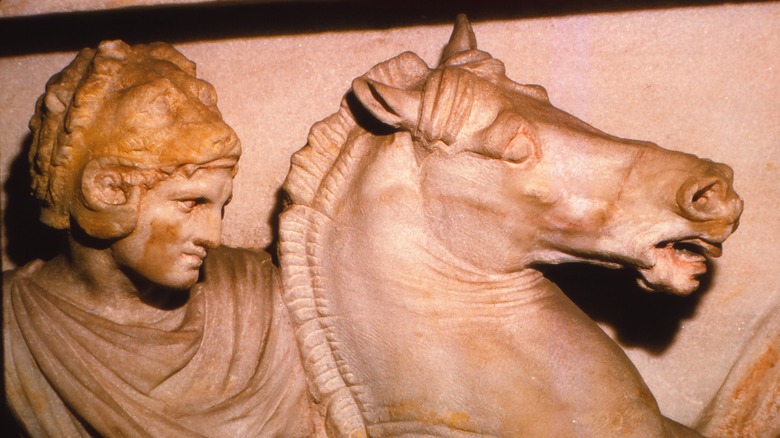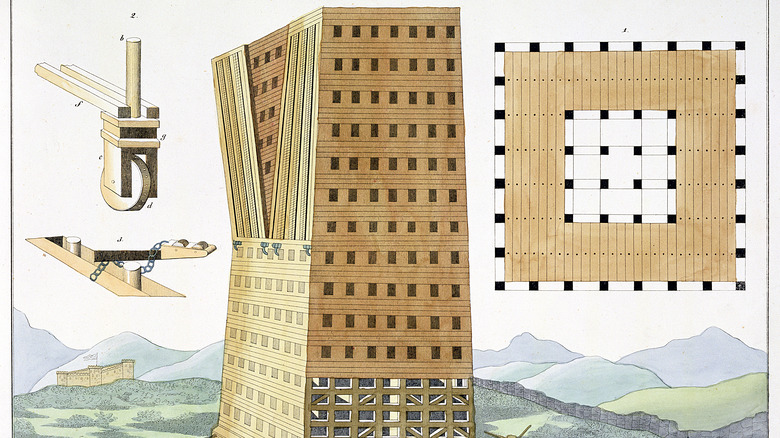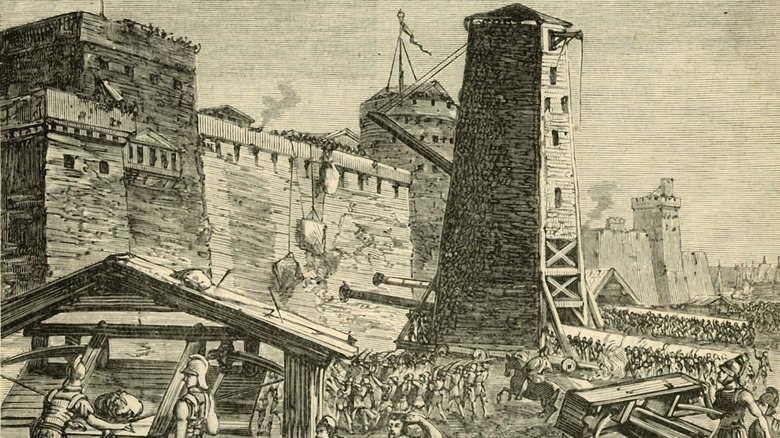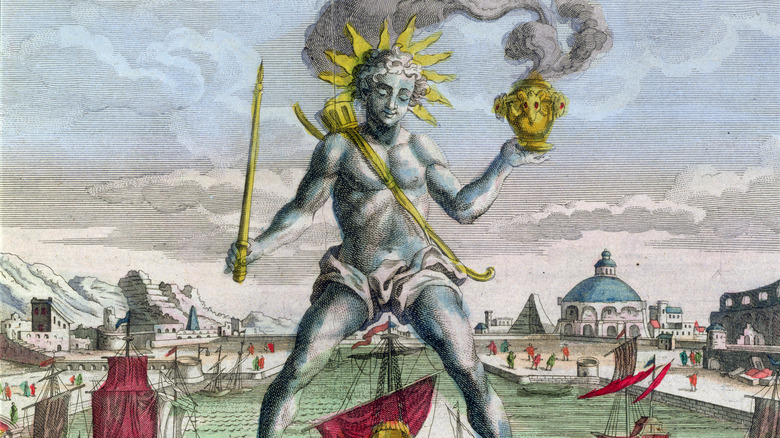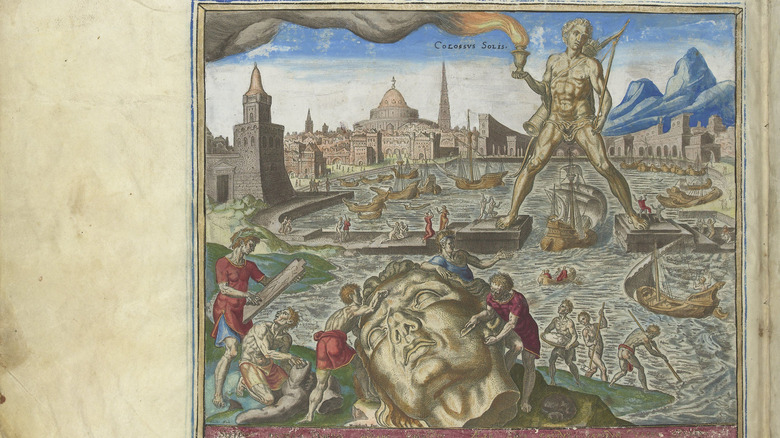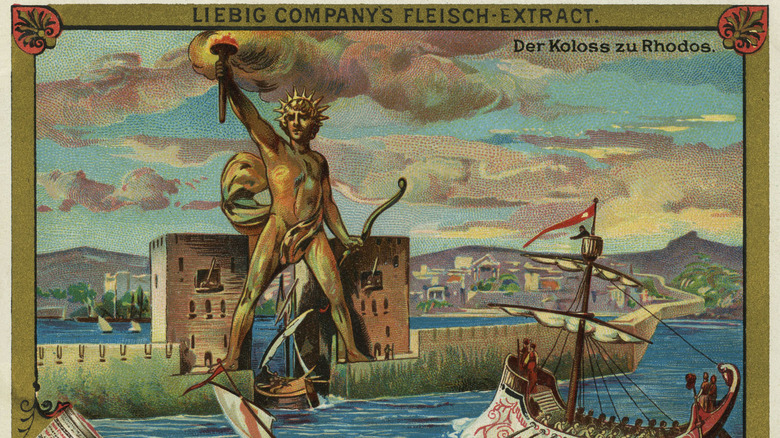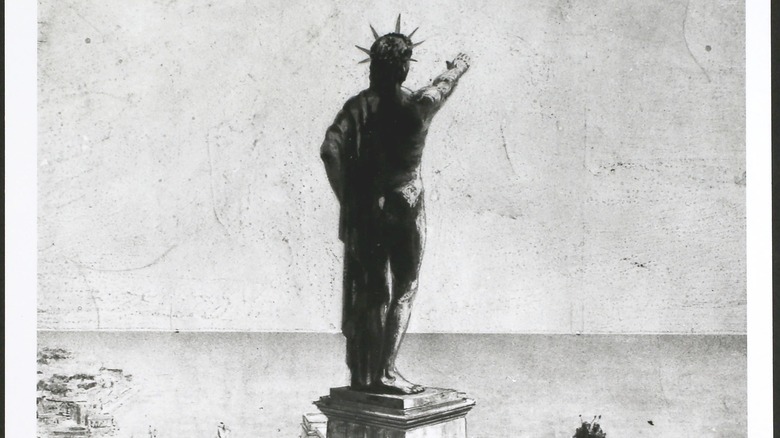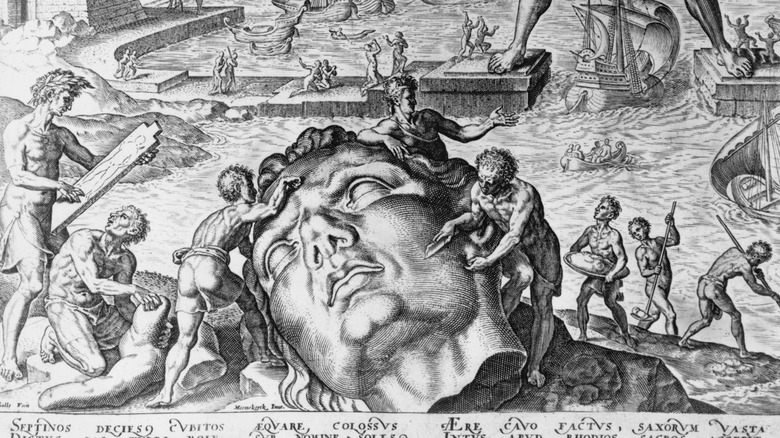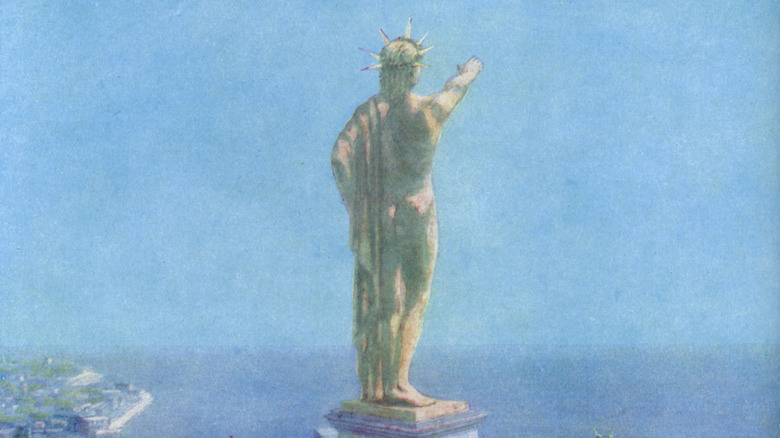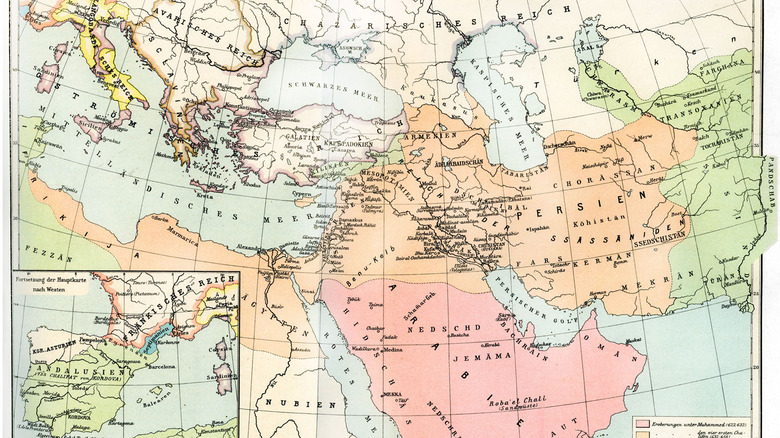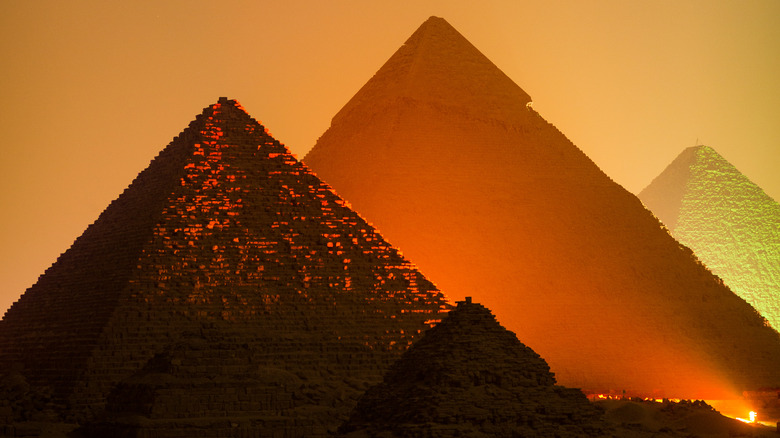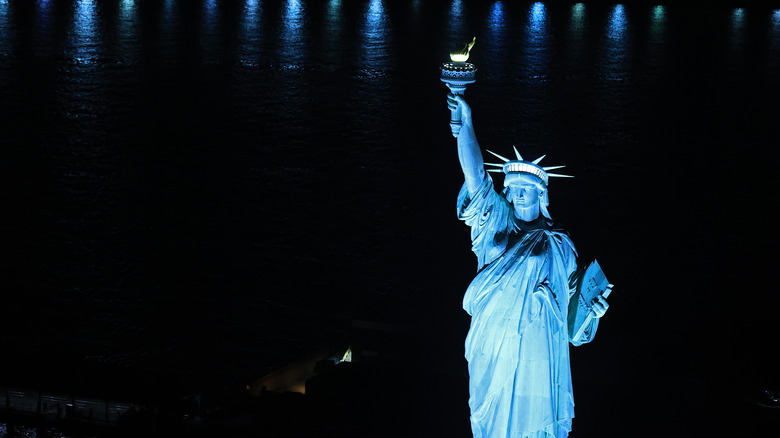The Untold Truth Of The Colossus Of Rhodes
According to NPS, inscribed on a pedestal on the Statue of Liberty is a poem by Emma Lazarus titled, "The New Colossus." While the lines "Give me your tired, your poor, your huddled masses yearning to breathe free," are well-known in the American lexicon, the title and the opening lines directly reference the Statue of Liberty's main source of inspiration: "Not like the brazen giant of Greek fame, With conquering limbs astride from land to land."
Even more than 2,000 years after its erection, the Colossus of Rhodes still fascinates the world. During its short existence, the statue was called one of the Seven Wonders of the Ancient World, and it was inspiration for many works of art (most famously, the Statue of Liberty).
The Colossus of Rhodes is a testament to the engineering of the ancient world and the mixture of art and religion during the Hellenic period. And much like the period, the statue's legacy helped shape modern society. Here is the untold truth of the Colossus of Rhodes.
Alexander the Great conquers Rhodes
The Colossus of Rhodes has its origins in the conquests of Alexander the Great. In little more than a decade, the Macedonian king would conquer much of the ancient world, from the far reaches of western Europe to Africa.
According to the History of War, Alexander the Great's strongest opponent was Memnon of Rhodes. Memnon's father, Timocrates of Rhodes, was a Greek citizen who worked for the Persian Empire. Memnon and his brother, Mentor, worked as military commanders for the Persian Empire and helped expand its borders. After his brother's death in 340 B.C., Memnon was appointed as commander in the Troad, in the northwest of Asia Minor. His territory bordered Macedonia, and when the city-state began its own empire building, Memnon and his troops faced its soldiers often on the battlefield.
In 334 B.C., the Macedonian leader Philip II was assassinated, and his son, Alexander, inherited the throne. Philip had spent two years battling Memnon, but his son saw greater success. This was not Memnon's fault. War History Online reports that Memnon's strategy in facing Alexander the Great was dismissed by his superiors, leading to the Persians' eventual defeat. In 333 B.C., just as his superiors finally gave him the supplies and men to employ his own strategy against Alexander, Memnon died of an illness. Uniglobe Phillips Travel reports that in 332 B.C., Rhodes became part of Alexander the Great's empire and the Persian Empire fell.
Rhodes after Alexander the Great
After Alexander the Great's death at the age of 32, the future of Rhodes, as well as the rest of his empire, was left in question. Alexander had no children, hence no one to leave his empire to. Geographics explains that the empire was divided up by three of Alexander the Great's lieutenants, Ptomely, Seleucus, and Antigonus. Each took a hold of different territories, and they went on to battle for control of the whole empire in what would become known as the Wars of the Successors.
According to Livius, the island nation of Rhodes held great importance in the power balance. Rhodes held the entrance to the Aegean Sea and controlled the route to the eastern Mediterranean Sea. It also sat around 11 miles from Asia Minor. Because of this, Rhodes' wealth and importance grew while it attempted to maintain neutrality among the surrounding battles for the empire.
However, the island did eventually form a close association with Ptomely, who ruled Egypt. This would catch the attention of Antigonus, who ruled nearby Asia Minor. Already fighting throughout the old empire with Ptomely, Antigonus did not desire such an important territory to be loyal to his enemy.
The Siege of Rhodes
The moment of truth finally came in 305 B.C. when, as told by Weapons and Warfare, Demetrius Poliorcetes, son of Antigonus invaded Rhodes following a successful campaign to take Cyprus from Ptomely of Egypt. Bolstering a massive siege army, the son of the former general spent 305-304 B.C. attempting to take Rhodes.
On paper, Demetrius and his army should have easily overwhelmed and destroyed the Rhodian forces. According to Geographics, the island nation faced an invasion force of 40,000 men, as well as swarms of pirate ships hoping to plunder the city after it fell. By comparison, Rhodes' military was made up of only 7,000 men. However, because of their strong fortifications in the city, and a defended harbor that allowed them to receive support from Ptolemy and stave off starvation, the Rhodians were able to weather the onslaught. Despite their overwhelming numbers and vast weaponry, Demetrius' army just could not break through the walls of the city.
In an act of desperation, Demetrius ordered the construction of many siege weapons, such as catapults and battering rams. Their most famous weapon was the Helepolis, a siege tower standing at 131 feet high, 65 feet wide and weighing over 160 tons. Made of up wood and covered in iron plates to prevent fires, Demetrius' army was still unable to take the city. Finally, Demetrius sued for peace and ended the siege in defeat in 304 B.C.
Victory and celebration
According to World History, aside from earning the nickname, "the Besieger of Cities," Demetrius obtained nothing else from his attempted siege. After successfully holding off its invaders, the citizens of Rhodes took the remnants of the materials left by their invaders and sold them for massive profit. Geographics reports that the total profits from selling off the siege weapons, including the Helepolis, was around 300 talents of silver, or $6.4 million today. This coupled with their already successful economy and jubilation for maintaining their independence led to the idea to build a monument to themselves. This was the beginning of the idea for the Colossus of Rhodes.
The citizens of Rhodes believed that the god of the sun, Helios, had spared them and willed them to victory. Helios was the patron god of Rhodes, and much of the city's culture centered around him. An annual festival to Helios took place, and Rhodes also had a Panhellenic Games, simpler to the ancient Olympic Games, in his honor. Rhodes itself was named in honor of Helios, as its name came from the nymph Rhodos, who gave birth to Helios' seven children.
So, when it came time to honor the god they believed led them through such a dark period in their city's history, the citizens of Rhodes decided to use the profits from selling off Demetrius' supplies to fund a statue of Helios. Little did the world know that the statue they would build would be something never seen before.
Construction of the Colossus of Rhodes
According to Liberty Cruise, it took France nine years to build the Statue of Liberty between 1875 and 1884. Amazingly, despite the 2,000 year difference between the Colossus and Lady Liberty, Rhodes' massive statute took only three more years to build. As told by Geographics, construction on the monument began in 292 B.C. and concluded in 280 B.C.
To construct the behemoth, the Rhodians did not have to look far. Chares of Lindos, a resident of the island, was recommended to lead construction by a fellow sculptor named Lysippos, who was the personal sculptor of Alexander the Great. Lysipppos had also built a 72-feet statue of Zeus in the city of Tarentum.
The Colossos of Rhodes stood on a 49 feet tall white marble pedestal. According to Wind Star Cruise, the statue's internal support was made up of stone pillars and iron beams. To form the statue's skin, molded bronze plates coated the iron framework. However, because of its size, Chares was forced to build an earthen ramp around the statue in order for workers to climb to work on the project. The ramp blocked the view of the statue, meaning that only those working on the statue would know what it actually looked like. Chares himself did not live long enough to see the completion of his greatest project, Gretour reports. But finally, after 12 long years, the statue was complete.
Inscribed at the bottom of the statue was an epithet to Helios.
What did the Colossus of Rhodes look like?
According to Greeka, the Colossus of Rhodes is believed to be the tallest statue of the ancient world. The statue would tower over most structures in today's world, let alone the ancient world. By some accounts, the statue stood at 98.4 feet, as told by SoftSchools, while other accounts, like The UI Junkie, list the statue closer to 125 feet tall. According to Geographics, the size of the statue was so unbelievable, the Greeks invented a new word to describe a statue of such height, "colossus." Hence the statue became known to the outside world as the Colossus of Rhodes.
Amazingly enough, despite it becoming one of the most fascinating objects of its time, there is not a surviving contemporary description of the Colossus of Rhodes. However, through the ages, painters and sculptors have constructed their own images of the statue. A popular description of the Colossus of Rhodes is that it stood on the entrance of the harbor, and ships would pass between its legs to enter the city.
However, based on the technology of the time and the dimensions of the statue and the harbor, this would be impossible. This image is believed to originate from an Italian painter who visited Rhodes centuries after the statue's demise. Other descriptions include the statue holding a torch, similar to the Statue of Liberty, and one of Helios shielding his eyes from the sun.
The Colossus of Rhodes wasn't around for long
A citizen of Rhodes could have lived their entire life and seen both the construct of the statue and its destruction. Despite the legacy the magnificent statue garnered in the ancient world, the Colossus of Rhodes only stood for about half a century, as told by World History. Despite this fact, the Colossus became both a symbol for Rhodes and a subject of fascination for travelers from outside of the city.
According to Geographics, citizens of Rhodes became known as Colossians, and the already economically fruitful city grew even wealthier with tourists traveling to get a glimpse at the mighty colossus. Rhodes became as much a cultural center of the world as a commercial center. In classical artwork, Helios is often depicted driving a chariot through the sky as he carries the sun around the world. While the statue did not replace this image, it certainly added a new way of displaying the sun god.
Writers and historians such as Herodotus, Callimachus of Cyrene, Antipater of Sidon, and Philo of Byzantium traveled to Rhodes to bear witnesses to the Colossus of Rhodes. Even after the statue fell, the writer Pliny the Elder said "But even lying on the ground, it is a marvel," Rhodes Guide reports.
The collapse of the Colossus of Rhodes
All great things come to an end eventually. Time and deterioration have taken down mighty empires throughout human history. And other times, Mother Nature decides to redecorate her house by sending natural disasters. As stated by Geographics, Rhodes sits on two tectonic plates and Rhodians did not possess the knowledge or ability to earthquake-proof their buildings.
According to All That's Interesting, the end of the standing statue came in 226 B.C., when a mighty earthquake shook the island. Rhodes suffered massive damage to its harbor and throughout the city.
World History Project reports that the Colossus of Rhodes snapped off at its weakest point, its knees, and fell to the earth. Computer simulations theorize that the earthquake caused a cascade failure in the rivets, causing the knees to buckle and the arms to separate at the shoulders. Soon after the disaster, Ptolemy III of Egypt offered to pay for the reconstruction of the famed statue. However, believing that the earthquake and the destruction of both the statue and much of the city was caused by an angry Helios, the Rhodians consulted the oracle of Delphi, who warned against rebuilding the statue. Rhodes followed the oracle's warnings and did not rebuild the colossus.
The remains of the Colossus of Rhodes
In a testament to the popularity of the Colossus of Rhodes, the remains of the gargantuan statue would be commonplace in Rhodes society for more than 800 years. According to Wonders of the World, the statue increased the prestige of the island nation, which might have been a reason for its remains staying in place following the earthquake.
Even though the Colossus of Rhodes was left in shambles on the ground, this did not deter visitors from around the world from traveling to see its remains. Rhodes was still an economic power and had a reputation for their navigation and maritime abilities, as told by Greeka. But eventually, a new world superpower would come and take the city. In 70 A.D., almost 400 years after the Macedonian general Antigonus failed to capture the city, Rhodes fell to the Roman Empire.
Rome held Rhodes for three centuries until, as the Roman Empire split, the territory became a part of the Byzantine Empire. In spite of changing empires, the remains of the great statue stayed in the city.
The Colossus of Rhodes is completely destroyed
An earthquake could not rid Rhodes of its famed statute, but an emerging empire closed the book on the Colossus of Rhodes. According to Geographics, in 653 A.D., the island of Rhodes fell to another global empire: the Umayyad Caliphate.
Just like how the Rhodians sold the remains of Demetrius' forces for scraps, so too was the famed statue used by the Arab invaders, as told by History. It is said that the bronze that made up much of the statue was hauled away on 900 camels. The Colossus of Rhodes was built to celebrate a victory for the people of Rhodes over forces far superior to their own. Once the statue was no longer in the city, it seemed as if that luck ran out. Rhodes was still a valuable territory, and any empire seeking to expand its borders had the island nation as a priority on its list. According to Greeka, Rhodes has been occupied by the Persians, Saracens, Venetians, Ottomans. and Italians before returning to the Greeks after World War II.
One of the Seven Wonders of the Ancient World
Despite standing for only a little more than half a century, the great statue of Helios left a remarkable impact on the ancient world. According to History, the Colossus of Rhodes is considered one of the Seven Wonders of the Ancient World. First listed in 225 B.C. in Philo of Byzantium "On The Seven Wonders," the statue's destruction did not stop the writer from putting it on the same level as the Great Pyramid of Giza and the Statue of Zeus in Olympia.
In fact, the Colossus of Rhodes' was around at a perfect period in time. According to Geographics, while the statue was standing, a new form of tourism began to spring up, where wealthy individuals documented the "wonders" they had seen on their journeys. It was through these chronicles that the seven wonders were listed, as well as the interest in the statue that exists to the modern day.
The Statue of Liberty and the legacy of the Colossus of Rhodes
The Statue of Liberty is one of New York City's major tourism attractions. The statue is a symbol of the United States and its presence was long considered a welcoming sign to immigrants traveling to the country hoping to make a better life for themselves and their families. So it does not come as a surprise that, as told by New World Encyclopedia, the Statue of Liberty is directly inspired by Colossus of Rhodes.
Because of the lack of an actual description of the Colossus of Rhodes, the Statue of Liberty design is based on an idea of the great statue and classic images throughout the century, Greek Reporter says.
The Statue of Liberty isn't the only tribute to the Colossus of Rhodes. Hundreds of paintings and sculptors have paid tribute through the centuries. Sylvia Plath's poem, "The Colossus" and Emma Lazarus' "The New Colossus” are the two most famous poems written with reference to the statue. According to Geographics, investors have proposed rebuilding the statue today, showing that the Colossus of Rhodes, millennia after its collapse, still fascinates the globe.

